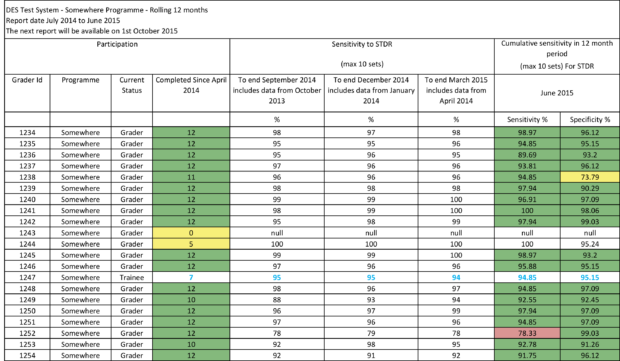The success of screening depends upon its ability to find those who have the condition the programme is testing for.
The NHS Diabetic Eye Screening (DES) Programme aims to reduce the risk of sight loss in people with diabetes by the early detection, and treatment if necessary, of sight-threatening diabetic retinopathy. DES screeners take digital photographs of the back of the retina and trained graders then study these images. They grade images based on the health of the tiny blood vessels in the retina. Consistent, high quality grading that accurately identifies people who have referable disease is therefore essential for a safe, efficient screening service.
The DES programme has recently taken major steps to improve the quality and consistency of grading throughout England by updating its testing system for graders and rolling out new performance management reports. All DES graders must interpret and grade a minimum number of retinal images on the national test and training (TAT) system. And the national programme is rolling out new performance management grading reports based on the TAT results. These reports use a traffic light flagging system (see Figure 1) to identify the safety level of graders. They measure graders’ ability to identify sight threatening diabetic retinopathy (STDR) that needs to be referred to hospital eye services.

The reports refresh at the end of every quarter and calculate both sensitivity – the ability of graders to correctly identify people with disease – and specificity – the ability to correctly identify those without disease. Graders must complete 10 full test sets over a 12-month rolling period to ensure the reports:
- are statistically valid in detecting outliers
- do not incorrectly label good graders as poor by chance because of small numbers
Programmes will be able to download the reports from TAT and export them into Excel as a record of performance. The screening quality assurance service will also automatically receive an anonymised version of the reports to cascade to commissioners. Graders will be flagged according to national guidance (Figure 2) and programmes will take appropriate action, such as additional support and a recovery plan, if graders are flagged amber or red.

This new process will improve the consistency of grading across the country, benefiting the DES programme as a whole. Most importantly, it will also benefit all those people with diabetes aged 12 and over who we invite for screening every year.
We have now published full grading quality assurance guidance for local programmes in a grading management guidance document.
PHE Screening blog
The PHE Screening blog provides up to date news from all NHS Screening programmes – replacing our previously published newsletters. You can register to receive updates direct to your inbox, so there’s no need to keep checking for new blogs.